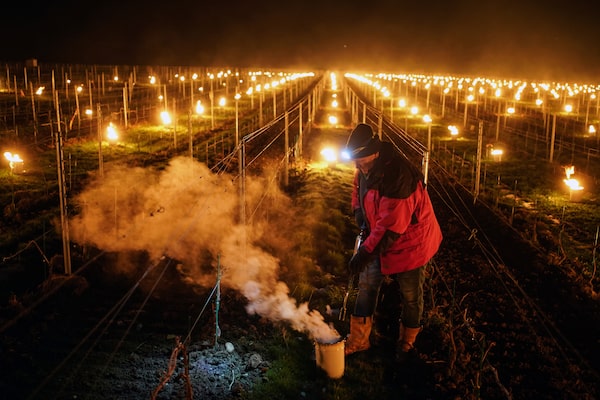
Wine grower Patrick Clavelin repairs a large anti-frost candle in a vineyard in Le Vernois, in the Jura region, central France, early on April 4.Laurent Cipriani/The Associated Press
For more wine advice and reviews, recipes, restaurant news and more, sign up to receive our Good Taste newsletter in your inbox every Wednesday.
Social media accounts for wineries in many parts of France recently broadcast pictures of vineyards alight with candles or larger fires to protect the vines and their tender new growth from frost. The dramatic images looked to be a repeat of last April when temperatures in many of France’s vineyards repeatedly dropped below freezing for 11 days.
In the wake of the 2021 cold snap, grape growers reported devastating losses as high as 80 per cent. Several appellations only harvested half of the normal yield of grapes.
Last week, grape growers and wineries in Champagne, Bordeaux and Burgundy worked diligently on April 3 and 4, as France recorded its coldest night since 1947. Temperatures fell to -9 C in parts of Champagne, while areas of Bordeaux and Chablis recorded -7 C and -6 C, respectively. Those temperatures are low enough to cause damage, but it’s too soon to assess the effect of the frost. (Record cold incidents were also observed in Germany, Spain and Austria.)
Frost rarely affects vineyards equally, so some vines might have only suffered minor damage. Others may face more serious damage. Not all grape varieties are equally susceptible to chilly conditions, and susceptibility depends on bud-development stages.
Using candles or fires to raise the temperatures around the vine is a common defence against frost in many parts of Europe. The aim is to produce enough heat to prevent frost pockets from settling. Other measures vary from sprinkler systems, fans or even helicopters flying low over vineyards to circulate the air. The expense in materials and man power means that the best vineyard parcels are a priority for wineries.
The damage faced in 2021 was far more severe because vineyards were farther along in the growth cycle due to warmer temperatures in March, which coaxed vines out of dormancy earlier than usual. There was more tender vegetation to suffer ill effects of the cold.
Climate research shows an increase in warming late-winter and early-spring temperatures, which spur growth in vineyards before the threat of freezing temperatures has passed. While frost incidents are a normal risk facing grape and tender fruit growers, the increase of false springs increases the damage to that year’s crop and potentially the long-term health of the vine.
Growers and winemakers in affected areas will need to see how the buds react in the coming days and weeks to gauge the extent of the damage. The threat of frost will be a concern in cooler-climate regions until the end of May.
E-mail your wine and spirits questions to The Globe. Look for answers to select questions to appear in the Good Taste newsletter and on The Globe and Mail website.
 Christopher Waters
Christopher Waters